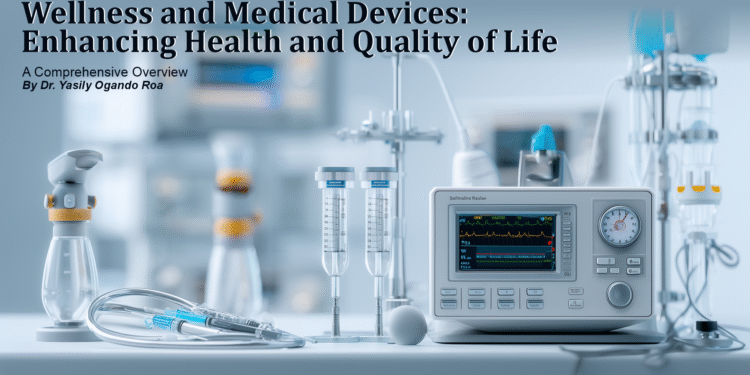By Dr. Yasily Ogando Roa
Introduction
In our journey toward a healthier future, wellness and medical devices have emerged as beacons of hope and empowerment. These remarkable innovations are transforming the way we approach health, offering us the tools to monitor, manage, and elevate our quality of life. This article delves into the various types of wellness and medical devices, their profound benefits, and the guiding hand of regulatory bodies ensuring their safety and efficacy.
Wellness Devices
Wellness devices are the torchbearers of a healthier lifestyle, encouraging us to embrace habits that nurture our well-being. Designed for everyday use, these devices inspire us to lead a life filled with vitality and purpose. The most common wellness devices are:
Fitness Trackers
Devices like these are more than just gadgets—they are companions on our wellness journey. By monitoring physical activities, heart rate, and sleep patterns, they motivate us to stay active and set ambitious fitness goals. With real-time feedback and progress tracking, these devices empower us to make informed choices for a healthier, more fulfilling life.
Smart Scales
Smart scales provide a comprehensive view of our health journey. By measuring body weight, body fat percentage, and other metrics, they offer insights that guide us toward achieving our wellness aspirations. These scales sync with apps to track progress over time, delivering personalized recommendations that help us stay on course.
Meditation and Stress Relief Devices
Gadgets like these are allies in our quest for mental well-being. Through guided meditation and breathing exercises, they help us manage stress and cultivate mindfulness. These devices promote relaxation and emotional balance, empowering us to navigate life’s challenges with grace and resilience.
Medical Devices
Medical devices are the guardians of our health, dedicated to diagnosing, monitoring, and treating medical conditions. They play a crucial role in managing chronic illnesses and improving patient outcomes, offering hope and healing to countless individuals. Some notable examples include:
Glucose Monitors
These devices are lifelines for diabetics, continuously monitoring blood sugar levels and providing real-time data. These monitors enable timely action and effective management of diabetes, fostering a healthier, more balanced life.
Blood Pressure Monitors
Home blood pressure monitors are instruments of empowerment. By allowing users to track their blood pressure and share data with healthcare providers, these devices facilitate early detection of hypertension and support cardiovascular health.
Wearable ECG Monitors
By providing electrocardiogram (ECG) readings, they help detect irregular heart rhythms and potential cardiac issues. These monitors offer a convenient way to monitor heart health, aiding in the early diagnosis of conditions like atrial fibrillation.
Smart Inhalers
These smart inhalers collect data on inhaler use and environmental factors, providing insights to optimize asthma management.
Regulation of Wellness and Medical Devices
Wellness devices are regulated, but the level of regulation varies depending on the type of device and its intended use. In the United States, the Food and Drug Administration (FDA) plays a key role in regulating wellness devices. The FDA’s General Wellness: Policy for Low-Risk Devices provides guidance on products that promote a healthy lifestyle and are considered low risk.
According to this policy, wellness devices that are unrelated to the diagnosis, cure, mitigation, prevention, or treatment of a disease or condition are generally not considered medical devices and are not subject to the same stringent regulations. However, if a wellness device makes claims related to health conditions or disease management, it may fall under stricter regulatory oversight.
Additionally, the Federal Trade Commission (FTC) also has a role in regulating wellness devices, particularly in terms of marketing claims and consumer protection. Companies must ensure that their marketing claims are substantiated and not misleading.
The Future of Wellness and Medical Devices
The future holds exciting possibilities for wellness and medical devices. Innovations in AI, machine learning, and IoT (Internet of Things) are driving advancements in personalized health care. Devices are becoming more integrated, smarter, and user-friendly, enabling proactive management of health and well-being. As technology continues to evolve, we can expect even more sophisticated tools that empower individuals to take control of their health.
Conclusion
Wellness and medical devices are revolutionizing healthcare, making it easier to monitor, manage, and improve our quality of life. These innovations are not only enhancing individual health outcomes but also contributing to the broader goal of preventive and personalized medicine. As we embrace these transformative technologies, the future of healthcare shines brightly with endless possibilities.
Remember, your health journey is unique and full of potential. Embrace these tools, take charge of your well-being, and let your light shine brightly in the tapestry of life.
Is there a specific area within wellness and medical devices that you find most intriguing or inspiring? Let’s explore it further!








